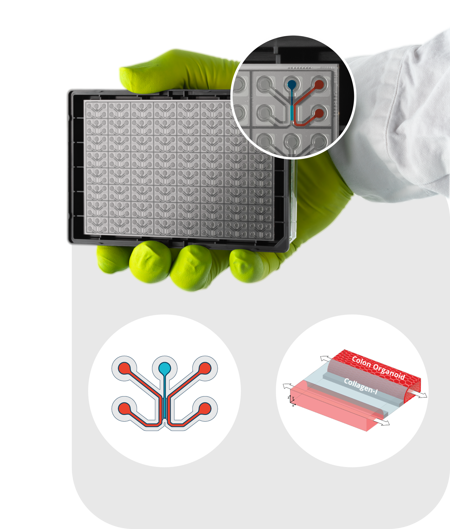Leiden, September 8, 2024 – MIMETAS has introduced the OrganoReady® Colon Organoid, a first-of-its-kind, ready-to-use 3D colon model derived from adult stem cells. Designed to advance gastrointestinal toxicity screening, this high-throughput model offers seamless integration into laboratory workflows, streamlining drug development.
 The OrganoReady Colon Organoid merges cutting-edge organoid technology with MIMETAS’ unique, membrane-free tubular cell culture platform, providing unrivaled apical and basolateral access. This feature enables precise testing for both oral and systemic drug exposure. Fully characterized with relevant biomarkers and transporters, the model is validated for multiparametric toxicity assessments, establishing it as a critical resource for drug developers.
The OrganoReady Colon Organoid merges cutting-edge organoid technology with MIMETAS’ unique, membrane-free tubular cell culture platform, providing unrivaled apical and basolateral access. This feature enables precise testing for both oral and systemic drug exposure. Fully characterized with relevant biomarkers and transporters, the model is validated for multiparametric toxicity assessments, establishing it as a critical resource for drug developers.
“Our new colon organoid model provides a reliable, translatable platform for predicting toxicity, helping researchers address potential risks at every stage of development,” said Bas Trietsch, CTO at MIMETAS. “With the OrganoReady format, we deliver adult stem cell-derived organoid technology—pioneered by the Clevers group—directly to our customers. This eliminates the months or even years typically required for licensing, sourcing, and culturing, allowing researchers to simply open a blister pack and begin.”
Key Features:
- 64 ready-to-use, perfusable colon tubules
- Apical and basolateral access for comprehensive oral and intravenous drug testing
- Full characterization with essential biomarkers and polarized transporter expression
- Validated for toxicity screening, ensuring accurate, reliable results
- Live human biology delivered directly to your lab
- No licensing required
The OrganoReady Colon Organoid enables efficient compound de-risking, drug safety testing, and enhanced understanding of gastrointestinal toxicity mechanisms. Its physiological relevance offers researchers a robust tool for more accurate prediction of adverse drug events, enhancing decision-making in drug discovery.
Learn more about the OrganoReady Colon Organoid and how it can enhance your research:
